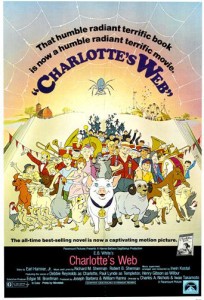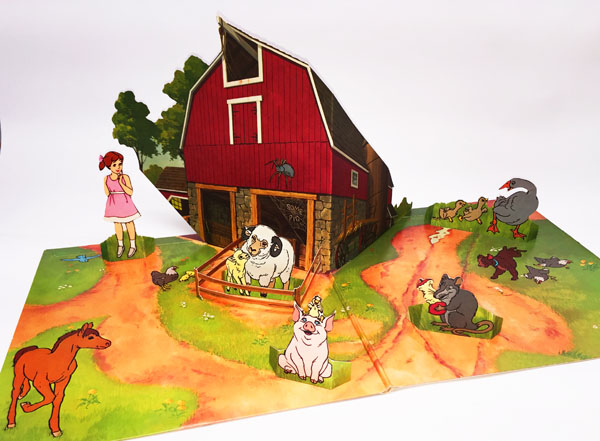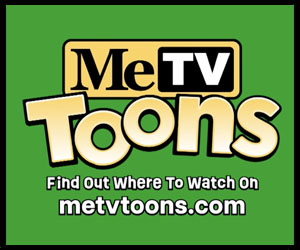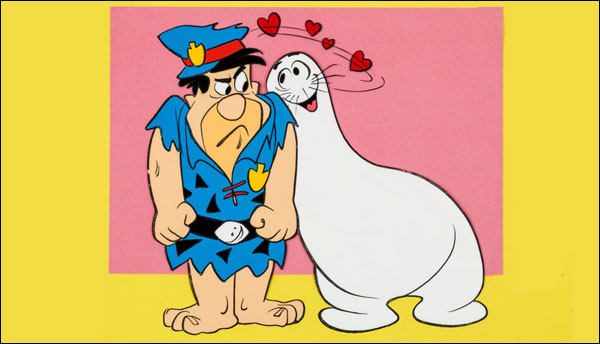A deep dig into the soundtrack from a film that generates strong emotions (positive and negative) with a Sherman Brothers score controversial simply by its presence.

Paramount Pictures Presents
A Hanna-Barbera/Sagittarius Production
CHARLOTTE’S WEB
Original Sound Track Recording
Paramount Records PAS-1008 (Stereo / 12” 33 1/3 RPM LP)
Released in 1973. Producer: Tom Mack. Music Supervisor/Arranger/Conductor: Iriwn Kostal. Music Coordinator: Paul DeKorte. Original Scoring Mixers: Artie Becker, Ami Hadani. Re-Recording Engineer: Dave Wiechmann. Running Time: 28 minutes.
Voices: Debbie Reynolds (Charlotte); Paul Lynde (Templeton); Henry Gibson (Wilbur); Agnes Moorehead (Goose); Pamelyn Ferdin (Fern Arable); Dave Madden (Sheep); Bob Holt (Homer Zuckerman); Joan Gerber (Edith Zuckerman); John Stephenson (Fair Announcer); Bill Lee, Gene Merlino, Jackie Ward, Bob Tebow, Paul DeKorte, Joann Alberts, Dick Bolks, Fred Frank, Susie McCune, Jay Meyer, Jackie Allen, Paul Sandberg (Singers)
Songs: “There Must Be Something More,” “I Can Talk,” “Chin Up,” “Mother Earth and Father Time,” “We’ve Got Lots in Common,” “A Veritable Smorgasbord,” “Deep in the Dark/Charlotte’s Web,” “Zuckerman’s Famous Pig,” “Charlotte’s Farewell (Mother Earth and Father Time)” by Richard M. Sherman, Robert B. Sherman.
Instrumentals: Main Title (“Charlotte’s Web,” “Mother Earth and Father Time,” “We’ve Got Lots in Common,” “Zuckerman’s Famous Pig”), “Chin Up March,” “End Title (“Charlotte’s Web,” “Zuckerman’s Famous Pig,” “We’ve Got Lots in Common”) by Richard M. Sherman, Robert B. Sherman.
 Like Charlotte herself, the beauty of Hanna-Barbera’s version of Charlotte’s Web comes from within. It was produced during H-B’s post-Scooby-Doo days, when the studio was in complete factory mode, thus making the feature much less polished than 1964’s Hey There, It’s Yogi Bear or even 1966’s The Man Called Flintstone. The cels are dusty and the animation, though above H-B’s TV average, inconsistent.
Like Charlotte herself, the beauty of Hanna-Barbera’s version of Charlotte’s Web comes from within. It was produced during H-B’s post-Scooby-Doo days, when the studio was in complete factory mode, thus making the feature much less polished than 1964’s Hey There, It’s Yogi Bear or even 1966’s The Man Called Flintstone. The cels are dusty and the animation, though above H-B’s TV average, inconsistent.
This Paramount film (which went into wide release 43 years ago today) came at the tail end of a history of backstage politics (the Hubleys and Gene Deitch were all involved with bringing the story to the screen and were wounded in the process). The resulting film displeased the author and his wife (who called it “a travesty”). So how could it be considered one of the best animated features of the 1970’s?
Because somehow it worked. Touched by witnessing the onscreen death of a creature that they would have otherwise squished, children and adults came out of theaters with teary eyes. Critics were impressed, especially that Hanna-Barbera could pull it off. As one of the earliest animated features to be released on home video (partly because it wasn’t Disney and not a box office smash), the feature sustained rentals and sales for years, before and after Disney started opening its vaults to VHS and DVD—thus ingraining it further into generations of collective memories.
Among the many reasons that Hanna-Barbera’s Charlotte’s Web beat the odds and still stands as a beloved adaptation of one of the greatest classics of children’s literature is that H-B did with Charlotte Walt Disney did with Mary Poppins (another film that displeased its author depending on the day of the week she was asked)—they brought in additional talent to elevate the production and put their best in-house artists in key roles whenever possible.
Celebrated writer Earl Hamner (The Waltons, The Twilight Zone), was an inspired choice to adapt the script. “My agent called and he said, ‘You’ve been offered this job,’ and I said, “Yes! I’d do it for nothing!’” Hamner told Stu Shostak at stusshow.com. “He said, ‘You will not!’ When I was working on the script, the phone rang and someone said, ‘Earl, you sound all choked up. What’s wrong?’ And I said, ‘A spider just died.’ So I was that involved with the script emotionally.”
Hamner’s script was so faithful to the book, one can almost read portions of the book along with the film. Very little was omitted, the “Dr. Dorian” chapter being the biggest edit. Fern’s indifference to Wilbur losing first prize at the fair is also softened in the film.
Few voice casts have ever been more perfectly assembled for an animated film. To this day, Debbie Reynolds is handed more Charlotte’s Web soundtrack albums to autograph than any other memorabilia from her vast career. Dave Madden considered the sheep a favorite role. Pamelyn Ferdin credits the film with helping inspire her to fight for animal rights.

Paul Lynde’s performance as Templeton the Rat became so iconic that Gary Winick, director of the 2006 live-action/CG remake of Charlotte’s Web, revealed that his fairground scenes with Templeton in his film had to be extended because test audiences were disappointed that the “Smorgasbord” song was missing.
Perhaps more than anything else, Hanna-Barbera’s version was blessed with the music and lyrics of the Sherman Brothers and the musical supervision of Irwin Kostal, teaming the trio again after Mary Poppins, Chitty Chitty Bang Bang and Bedknobs and Broomsticks. With endless respect to E.B. White (whose Charlotte epitaph, “A True Friend and Good Writer” may also be engraved on this writer’s final mile marker), taking the songs out of H-B’s Charlotte is like taking the songs out of Rodgers & Hammerstein’s Carousel or Lerner and Loewe’s My Fair Lady — the source material is still classic, but it loses something substantial.
 Charlotte’s death is heartrending in the book. When accompanied by the music, lyrics and meaning of “Mother Earth and Father Time,” it is—subjectively–heart-searing. This is the essence of why musicals are so uniquely powerful as an art form: the songs advance the story and provide emotion impossible to convey otherwise.
Charlotte’s death is heartrending in the book. When accompanied by the music, lyrics and meaning of “Mother Earth and Father Time,” it is—subjectively–heart-searing. This is the essence of why musicals are so uniquely powerful as an art form: the songs advance the story and provide emotion impossible to convey otherwise.
Granted, the same may not hold true for “I Can Talk,” in which Wilbur makes much ado about gaining the power of speech at Zuckerman’s farm. In the book, he simply begins speaking with the other animals with no comment. Perhaps the song that most unnerved the author was “We’ve Got Lots in Common,” with its Broadway barnyard finish featuring a chorus line of chickens. As Gene Deitch revealed for the first time in 2012, White “was strongly against turning Charlotte’s Web into a song and dance musical, but that is exactly what Hanna-Barbera did with it!” White had long since signed away his right of approval, so it is unlikely that the Shermans, Hamner, Hanna, Barbera, Nichols, Takamoto or anyone else on the projects may have been aware of how he felt.
Seconds into the very beginning of the movie, as the strings swell into the title melody, one is forever attached to the music—a score, by the way, that was a personal favorite of hit songwriter Al Sherman, the father of Richard and Robert.
As arranger, Kostal once again brings his skills from Broadway as well as Disney to maximize the mood of each Charlotte’s Web song. There’s even a little musical bonus for H-B fans: Kostal (probably inadvertently) added a classic H-B touch to the “Chin Up March,” which accompanies Wilbur through the throngs of fairground admirers. The arrangement suggests Hoyt Curtin’s early cartoon compositions, particularly those heard in The Huckleberry Hound Show. When the chorus picks up the tune after the special award ceremony, it’s as if Curtin handled the arrangement himself (interestingly, the trailers for the film closed with this piece of music).

If there’s any criticism to be leveled at Paramount’s soundtrack album, it might be that there’s a tad too much reverb and the overall playing time is too short. It might have been nice if the album included, for example, the major key instrumental rendition of the title song and the fairground theme (which served as the countermelody in “A Veritable Smorgasbord”. The album packaging is impressive, though, with a pop-up barnyard and punch out play figures, making it an extra-special album release indeed. In addition to the LP, Paramount Records also released a 45 RPM single of Debbie Reynolds singing a pop version of the title song.
To date, MCA has expressed no interest in reissuing the soundtrack album of Charlotte’s Web, much less producing an expanded version. So how’s a reissue from Intrada, which has issued so many wonderful Disney soundtracks recently–or Quartet Records, which released a wonderful expanded soundtrack of the Sherman Brothers’ other big musical of 1973, Tom Sawyer? Hmm?
GIVE A LITTLE LISTEN
“A Veritable Smorgasbord”
This is the song that audiences missed in the 2006 live-action/CG remake of Charlotte’s Web, proving that the impact of a story is somehow lessened when a great song is absent. It’s Paul Lynde at his best, along with Agnes Moorehead, shortly after both had made an indelible mark on television as Uncle Arthur and Endora on Bewitched.


 GREG EHRBAR is a freelance writer/producer for television, advertising, books, theme parks and stage. Greg has worked on content for such studios as Disney, Warner and Universal, with some of Hollywood’s biggest stars. His numerous books include Mouse Tracks: The Story of Walt Disney Records (with Tim Hollis). Visit
GREG EHRBAR is a freelance writer/producer for television, advertising, books, theme parks and stage. Greg has worked on content for such studios as Disney, Warner and Universal, with some of Hollywood’s biggest stars. His numerous books include Mouse Tracks: The Story of Walt Disney Records (with Tim Hollis). Visit 





















































Truly one of the great “non Disney” soundtrack that the Sherman Brothers did along with Chitty,Chitty,Bang,Bang, Snoopy Come Home and The Slipper and the Rose. Zuckerman’s Famous Pig was done in a Barber Shop quartet (which William Hanna love) and a clip of Charlotte’s Web (A Vertable Smorgasbord was shown on the tv show Wonderama where host Bob McAllister was interviewing Paul Lynde who was promoting Charlottes’s Web.
As someone who saw this in its 1973 theatrical run, I’ll point out some other Sherman Bros.early 1970s non-DIsney scores that remain worth hearing are Snoopy Come Home and the already reviewed Golidlocks (DFE).
Paul Lynde, was for once…HEAVILY promoted as his role…HB must have really been heavily into “The Partridge Family” given Dave Madden’s role as the sheep (they twice that time, first later in 1973’s fall on some “Goober/Ghost Chaseers” and the entire 1974-early 75 “Partridge Family in 2200” promoted the Partridges, coincidentally produced by HB’s original TV sister studio, for live action Screen Gems! And the “Bewitched” connection, with Lynde AND Agnes Moorehead, who, given her death (again,in 1974), must have had her last appearance here…going back to the Flintstones (and again Screen Gems aka Columbia Pictures Teleivision aka ELP Communications aka CPT produced “Bewitched”a s well as “Partridge”) with :”Sammantha” (incidentally, in my opinion, one of the Flintstones lower points) without Moorehead or Lynde but with stars Dick York and Elizabeth Montgomery. Then there was that final “Flintstones” season (1965-66) opener “No Biz Like Show Biz” with that Pebbles/Bamm Bamm toddler singing act (also covered here), which I’ve actually liked, with Bewitched “witch doctor” Bernard Fox as Eppy Brianstone, thus linking to both HB and Paul Lynde (who would still be imitated on 1970s HB cartoons and their collaboration with Tex Avery around the time of Lynde’s death) with John Stephenson as the evil Wilford the Wolf versus 1981’s “Kwicky Koala” (storyman-actor Bob Ogle, credited in his acting profession under his real name of Robert Allen Ogle, imitating Bill Thompson as Avery’s own Droopy).
THe presence of the Sherman Brothers, Irwin Kostal, the fact that it was a feature film, with recognizable characters and easygoing storyline, and artwork would have made it easily mistakable for a Disney flick. Now (regarding the Color/Movielab credits) all they needed was Technicolor and Disney coproduction. (Think DePatie-Freleng’s Goldilocks special, which appeared three years earlier…)
While I’m not the biggest fan, there are some parts worth enjoying and the character of Templeton for some reason really reflectted a part of me, and still does………… all that was needed for the “Veritable Smorgaboard” scene (used in the original 1973 trailers) was the warhorse of someone (Templeton here) taking a leftoverr cake or pie or whatnot, then cutting a wedge but then eating the SURROUND part…..
I would love to see this soundtrack get released on CD. It’s one of my favorites.
After all this time it seems unlikely to be released on CD especially since CDs are now considered outdated technology. I got tired of waiting and just made my own CD from my copy of the soundtrack album.
A Sherman Brothers score is always a plus. I agree that the music adds dimension to the film in ways that are hard to measure.
The “Charlotte’s Web” film received quite a bit of discussion in the documentary film “The Boys” about the Sherman Brothers.
Thanks for sharing this!
Pamelyn Ferdin played Paul Lynde’s daughter in the “Paul Lynde Show” sitcom. Interesting that Paul promoted “Charlotte’s Web,” since he reportedly refused on-screen credit for his other H-B work.
As much as E.B. White hated the film, at least he didn’t live to see the movies based on “Stuart Little” and “Trumpet of the Swan.”
I thought Minkoff did a decent job with “Stuart Little” even if the first film didn’t match the originally book (which ended abruptly).
I’ve seen Trumpet of the Swan and it was totally different from the original book and of course it was a complete box office failure. E.B. White would have been doing 1090’s in his grave if he would of seen this lemon of a adaptation of his classic story!
TIME magazine panned this animated feature as well.
Charlotte’s Web was broadcast on CBS in a syndication block called Famous Classic Tales, which also included HB’s 20,000 Leagues Under the Sea and The Count of Monte Cristo from ’73-’74 or so. They all have a similar production design although Charlotte is longer and a little more eleborate. Any information on HB’s novel adaptations from this era would be greatly appreciated. They are long out of circulation and are extremely well made little cartoons.
elaborate
Some of the Kenner Famous Classic Tales were released on video, but not all of them, and not all at once. Here is one collection:
http://www.amazon.com/gp/product/B000MR9C4Q?psc=1&redirect=true&ref_=oh_aui_search_detailpage
This was the first in the series:
http://www.amazon.com/gp/product/B00008K79Y?keywords=connecticut%20yankee%20dvd&qid=1456875670&ref_=sr_1_2&refinements=p_n_theme_browse-bin%3A2650365011&s=movies-tv&sr=1-2
The first specials were produced by API in Australia, then Hanna-Barbera bought them and produced more specials, and other films from other companies were also included in the series, like Charlotte’s Web. There are a few pages on the net with lists that can help keep track of them in the search for individual DVD titles.
Thanks Greg. The Count of Monte Cristo is epecially good, from the music to the simplicity of the character designs contrasted with the beautiful backgrounds. An excellent animated short film.
On Kenner Famous Classic Tales many were indeed animated by API (Air Programs International)of Australia (the same company that brought you Around the World in 80 Days) which was later bought by Hanna Barbera including A Christmas Carol, The Prince and the Pauper, and others.While H-B and thier Australian subsidiary Hanna Barbera Pty Ltd (later Hanna Barbera Australia) animated A Connecticut Yankee in King Arthur’s Court (starring Orson Bean which had knights riding Harley Davidson chopper motorcycles),Davy Crockett on the Mississippi (with Jean Van Der Pyl as the voices of the twin young daughters of a pioneer in the wagon train),Tales of Washington Irving (The Legend of Sleepy Hollow and Rip Van Winkle starring Mel Blanc), And my favorite Black Beauty with a outstanding incidental score which was provided by a Australian stock music company.
Agnes Moorehead and Paul Lynde sound as if they are having a jolly old time singing this song. I never gave this a chance. I’ll have to look up both versions of this and compare and contrast, although I wonder what kind of film that Gene Deitch was expecting for I, too, am all for the animated film rising from the typical Broadway type of musical thing, especially when looked at from today’s perspective. I understand people liking that sort of thing, but I wince when filmgoers will only accept one type of animated film as a perfect film. I still wonder what type of full length animated feature would have been made in the golden age had MGM or Warner Brothers attempted such a thing. Would either of them have elevated the art form at all?
Here’s Gene’s account of his involvement with the film:
http://genedeitchcredits.com/roll-the-credits/39-e-b-white/
Certainly Gene’s take on the book would’ve been unique and strikingly different compared to what a 1970’s audience might expect. Seems like a sad case of typical Hollywood producers who think they knew best, and I suppose in the case of the final product, they did, since it did managed to continue to leave us i tears to this day.
E.B White wrote and narrated In the 1973 animated short The Family that Dwelt Apart for The National Film Board of Canada. The same year HB’s Charlotte’s Web came out.
At least with that, he could take pride in knowing how that turned out! I kinda dig the 1930’s look they gave the characters and design here (of course it reflected the time period well).
https://www.nfb.ca/film/family_that_dwelt_apart
FYI Charlottes’s Web is being broadcast on HBO Family both east and west channels this month. Check your local listings for day and times!
I still have this record album with the farmyard popup from my childhood but the stand-up characters disappeared sometime in the 1970s. I wonder if there’s anywhere that offers them to print off the internet? What are the chances anyone else who owned this album still has the original stand-ups, has scanned them in for distribution, and has made them available online?
I have 2 copies of the soundtrack…one is a beautiful picture disc I’m very proud of. Now that most of the cast is gen I’m hoping the soundtrack will become a valuable collectors item.
Pinterest might have something. It help me find a couple of nostalgia things I was looking for, image wise.😊
“Chin Up” was written for the unproduced Disney adaptation of “Hansel and Gretel,” AJ Carothers wrote the screenplay.